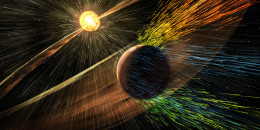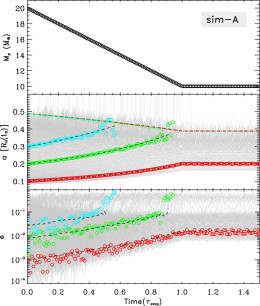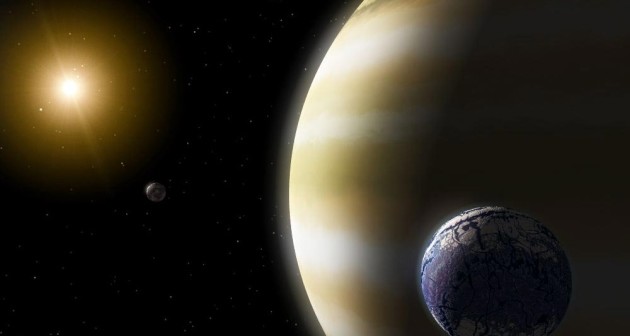In other solar systems, the radiation streaming from the central star can have a destructive impact on the atmospheres of the star’s close-in planets. A new study suggests that these exoplanets may also have a much harder time keeping their moons.
Where Are the Exomoons?
Moons are more common in our solar system than planets by far (just look at Jupiter’s enormous collection of satellites!) — and yet we haven’t made a single confirmed discovery of a moon around an planet outside of our solar system. Is this just because moons have smaller signals and are more difficult to detect? Or might there also be a physical reason for there to be fewer moons around the planets we’re observing?
Led by Ming Yang, a team of scientists from Nanjing University in China have explored one mechanism that could limit the number of moons we might find around exoplanets: photoevaporation.

Artist’s illustration of the process of photoevaporation, in which the atmosphere of a planet is stripped by radiation from its star. [NASA Goddard SFC]
Effects of Radiation
Photoevaporation is a process by which the harsh high-energy radiation from a star blasts a close-in planet, imparting enough energy to the atoms of the planet’s atmosphere for those atoms to escape. As the planet’s atmosphere gradually erodes, significant mass loss occurs on timescales of tens or hundreds of millions of years.
How might this process affect such a planet’s moons? To answer this question, Yang and collaborators used an N-body code called MERCURY to model solar systems in which a Neptune-like planet at 0.1 AU gradually loses mass. The planet starts out with a large system of moons, and the team tracks the moons’ motions to determine their ultimate fates.
Escaping Bodies

Evolution of the planet mass (top) in a simulation containing 500 small moons. The evolution of the semimajor axes of the moons (middle) and their eccentricities (bottom) are shown, with three example moons, starting at different radii, highlighted in blue, red and green. The black dotted line shows how the critical semimajor axis for stability evolves with time as the planet loses mass. [Yang et al. 2016]
The team finds that even in the best-case scenario of only small moons, no more than roughly a quarter of them survive the simulation still in orbit around their planet. In simulations that include larger moons further out, the system is even more likely to become unstable as the planet loses mass, with more moons ultimately escaping.
What happens to the moons that escape? Some leave the planet–moon system to become planet-like objects that remain in orbit around the host star. Others are smashed to bits when they collide with other moons or with the planet. And some can even escape their entire solar system to become a free-floating object in the galaxy!
Based on their simulations, the authors speculate that exomoons are less common around planets that are close to their host stars (<0.1 AU). Furthermore, exomoons are likely less common in solar systems around especially X-ray-luminous stars (e.g., M dwarfs) that can more easily drive photoevaporation. For these reasons, our best chances for finding exomoons in future missions will be around stars that are more Sun-like, orbiting planets that aren’t too close to their hosts.
Citation
Ming Yang et al 2016 ApJ 833 7. doi:10.3847/0004-637X/833/1/7


1 Comment
Pingback: L’impatto delle Stelle sulle Lune | Accademia delle Stelle